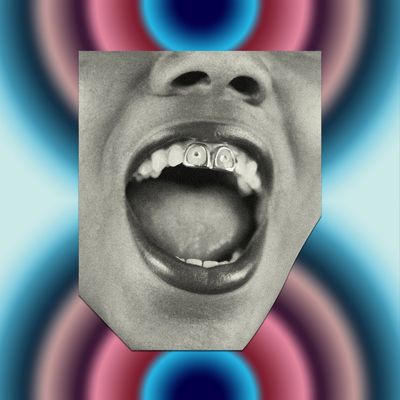
Think of tooth gems like smile beauty marks — tiny, sparkling stones stuck to your teeth and usually only visible when you smile. Blackpink’s Lisa, Billie Eilish, and Kim Kardashian’s 7-year-old son, Saint, were all spotted with the oral embellishments this summer. Should you join their ranks? Maybe. Before you make a decision, there are some health concerns to consider.
There are two general types of gems: permanent ones, which are set in tiny holes that have been drilled into your tooth, and semipermanent ones, which are basically glued to the surface. Whichever route you go, “this is definitely not a DIY process,” says Dr. Daniel Rubinshtein, a cosmetic dentist in New York City who has seen an uptick in gem requests in the past few years. Despite the popularity of tooth jewelry, he hasn’t made it part of his practice. “I’m personally not a fan,” he says. With both gem styles, “there is a significant chance they could dislodge, become swallowed, or even be aspirated into the airway, especially while you are sleeping.”
Even if the gem stays in place, there are other considerations. With permanent gems, a dentist needs to drill a hole into your tooth, which can cause damage to the enamel and to the tooth itself. Semipermanent styles are less invasive, but you still need to see a professional for application. The gem should stay put for at least a few weeks, but can last much longer — potentially until you decide to have it removed. The application is pretty straightforward: A dentist spreads an etching gel on the tooth surface, bonds the gem with an adhesive, then cures it to the tooth. “The operator technique has a big impact on how well the gem adheres to the enamel,” says Dr. Matt Nejad, a cosmetic dentist in Beverly Hills, California. “There are many different adhesives and flowable resins, and their performance varies greatly.”
With both styles, the gem or adhesive can discolor over time. A real diamond may be less likely to shade shift than cubic zirconia, colored stones, or plastic gems, but it costs more because … it’s a diamond. (Dr. Nejad says applying a semipermanent gem typically costs between $50 and $1,000, depending on the stone; rates for permanent application are higher.) You also have to be vigilant about cleaning. The area around the gem will be more prone to plaque buildup and, in some cases, tooth decay or gum disease. “Try to brush your teeth two to three times a day with an electric toothbrush to ensure you are getting to all those difficult areas around the tooth gem and removing any food that is stuck there,” says Dr. Rubinshtein.
While you’re contemplating a gem, factor in the need for (and cost of) a dentist appointment when you’re ready to take it out. Mouth jewelry may not be as permanent as a piercing or tattoo, but you can’t remove it yourself. In fact, Dr. Nejad says tooth damage during the removal process is more common than most people realize. “It even occurs when professionals remove orthodontic brackets, so imagine if someone with limited experience performs the procedure.” A dentist needs to use high-powered magnification and dental instruments to dislodge the gem and its adhesive without scratching the enamel or leaving residual adhesive behind. (With permanent gems, the hole will also need to be filled.) Another thing to consider: “If you have poor enamel from grinding your teeth or eating too many acidic foods, gems may cause tooth sensitivity,” says Dr. Rubinshtein.
Knowing all of the above, an inlaid, permanent stone seems like a much bigger risk to me. But I kind of love the idea of a temporary tooth gem, so long as you can handle the cost, upkeep, and the eventual removal process. And if you have any hesitation, there’s always a removable grill!
Jennifer Sullivan answers all your beauty-related questions with practical advice and zero judgment. Send your questions to AskABeautyEditor@nymag.com. (By emailing, you agree to the terms here.)
More Beauty Advice
- Are Pricey Sunscreens A Gimmick?
- What Is Skin Care With Growth Factors?
- How to Start Using Self-Tanner





